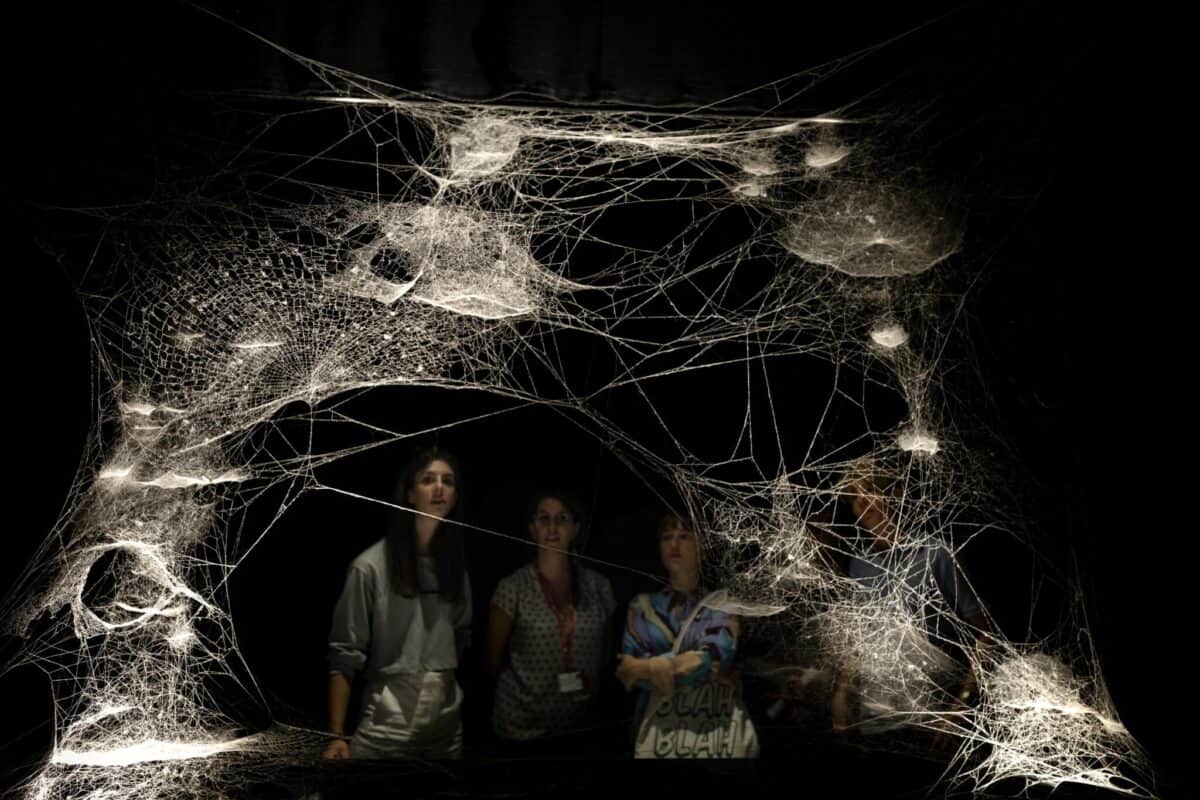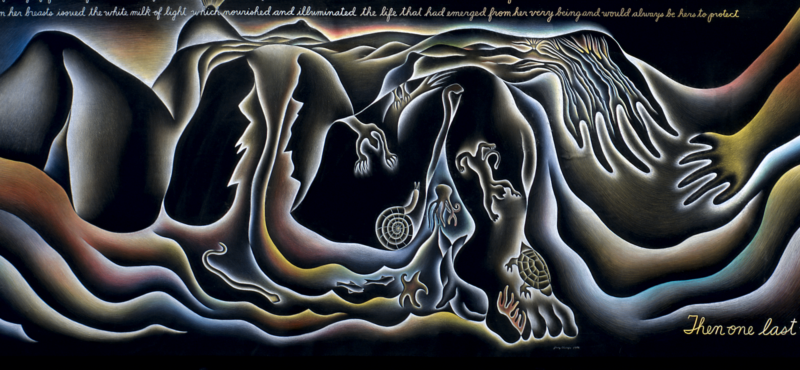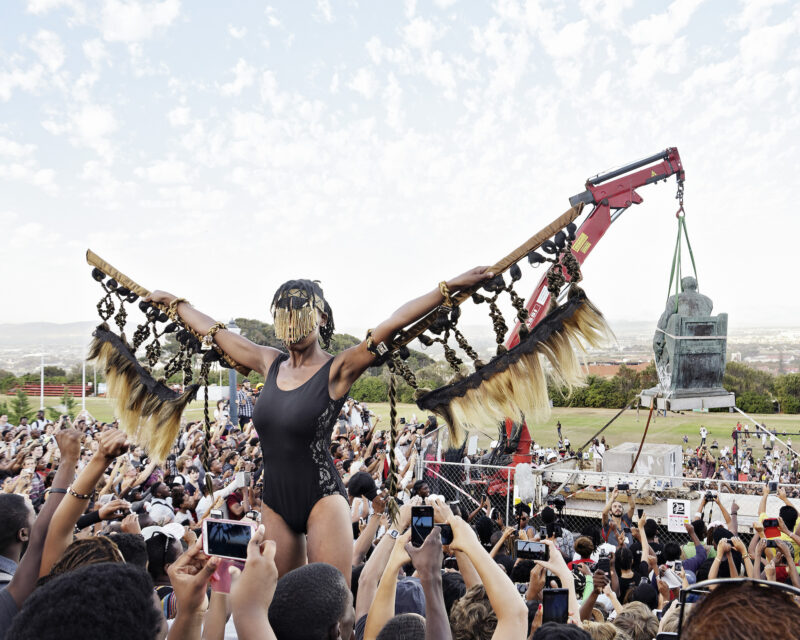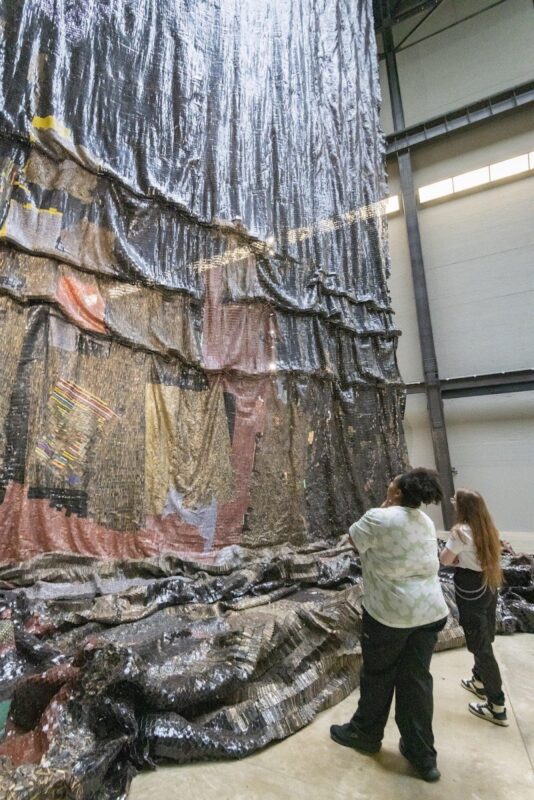
Opening next week Serpentine will present Web(s) of Life, the first major exhibition in the UK of artist Tomás Saraceno and collaborators, including spider/webs; the communities of Salinas Grandes and Laguna de Guayatayoc, Argentina; spider diviners in Somié, Cameroon; the ongoing research-driven community projects Aerocene and Arachnophilia initiated by the artist; as well as the life forms of the Royal Parks.
Tomás Saraceno will create a porous environment where Serpentine’s building and operations will respond daily to the immediate landscape of the surrounding park and weather conditions. It will bring together new and recent interactive works to propose how it is possible to take a more responsible, and responsive, approach to one’s actions in relation to other people, interspecies co-habitation, and the climate injustices unfolding across the world. Challenging the ways in which exhibitions are conceived and enacted, Web(s) of Life will become a ‘living organism’ that responds to the weather outside and the gallery’s unique location in the biodiverse habitat of the park and beyond.
In Web(s) of Life, Tomás Saraceno asks:
In the context of the environmental crisis and the need for a just, eco-social, energy transition, can the socio eco(nomical) debt of the global North be equitably taken into account? Can techno-diversity and biodiversity interact differently? Can systems of power move beyond the inequalities of capitalism and the reproduction of neocolonial extractivism of minerals and data? Can the privilege of digital memories over ancestral memories be overcome? Enter the spider’s dream, a space with codes of another ritual… It is high time some of us change our habits and not the climate!
Saraceno is a multimedia artist, who for more than two decades has produced a body of work that draws attention to our role in a complex network of relationships that make up an ecosystem. Web(s) of Life at Serpentine will delve into the many ways in which life forms, extractive technologies, and energy regimes are inextricably linked to climate injustice.
We’re honoured to partner with The Royal Parks to extend Tomás Saraceno’s exhibition beyond the walls of the Serpentine South Gallery and into Kensington Gardens. The most ambitious show in the UK to date by the Argentine artist, Saraceno will put his decades of research bridging the natural and social sciences, and visual arts into action as a fully participatory creative intervention that is as alive as the audiences it touches. Saraceno is moved by a desire to raise awareness on the climate emergency through practical solutions, and by activating the natural setting that surrounds us, this partnership promises to deliver on Serpentine’s mission of building new connections between artist and society.
Bettina Korek, CEO, Serpentine, and Hans Ulrich Obrist, Artistic Director, Serpentine,
The exhibition is conceived as a performative intervention into the Serpentine’s power supply, what the artist refers to as the “Ballad of Weather Dependency”. Energy for the exhibition will be generated by, and dependent on, solar panels newly installed on Serpentine’s roof. The artworks on display will adapt according to the daily levels of energy generated. The actions of the participants, the weather and fluctuating levels of energy play a crucial role in the exhibition.
The infrastructure of the Serpentine’s building will shift. Equipment used to control the temperature and humidity will be switched off and some doorways in the gallery will be opened to allow natural ventilation and encourage the movement of different forms of life.
Through these subtle interventions, the working habits of the gallery’s staff, the opening hours of the exhibition space and the ways in which visitors can participate and view the works will shift daily. Should a heatwave occur, rather than using climate control within the gallery space, areas of the exhibition will close, and visitors will be encouraged to engage with the multispecies and interactive sculptures that populate the exterior of the building and the park.
Saraceno has long called for close observation of spiders as a source of wonder and inspiration. The extraordinary architecture of their webs and their myriad behaviours encourage a move from arachnophobia (a fear of spiders) to arachnophilia (a love of spiders).

Inside, Saraceno will present a constellation of intricate spider webs woven in his Berlin studio, in collaboration with multiple spider species. A new work will repurpose a disused confessional booth, traditionally found in churches, as a space for communing with the vibrations of a spider. Upon entry, visitors will be invited to relinquish their mobile phones before encountering a projected film by the spider diviners of Somié, Cameroon that presents their intergenerational practice of ngam dù. Relieved of our phones and the ability to map and document our place in the world through real-time data, visitors are invited to slow down and use other senses. During ngam dù, binary questions are presented to a ground-dwelling spider whose responses are interpreted via its rearrangement of a set of cards that have been placed at the entrance to its burrow. Local diviner Bollo Pierre ‘Tadios’ invites visitors to ask the spider a question via their web portal titled Nggamdu.org. In an era of rapid technological advancement, Saraceno points to the practice of looking to bioindicators: organisms that can signal shifts in weather, climate, pollution levels, and ecological well-being.
Central to the exhibition is Saraceno’s filmic installation Fly with Pacha, Into the Aerocene (2020–23) which documents the artistic performance and flight of an aerosolar balloon sculpture over the salt flats in Salinas Grandes, Argentina. The flight marked the first ever fossil-free human flight without batteries, helium, hydrogen or lithium and was recognised as the most sustainable flight in human history by the Fédération Aéronautique Internationale (FAI), setting 32 world records. This was the result of extensive, collaborative research carried out by the Aerocene Foundation (an interdisciplinary group founded by Saraceno that seeks to devise new infrastructures of planetary mobility and ethics) and the indigenous communities of the Salinas Grandes and Laguna de Guayatayoc basin in Jujuy who are fighting for the preservation of land and water which is threatened by the mining of lithium – a material used predominantly in batteries for mobile phones, vehicles and other electrical devices – for an energy transition mainly in the global North at the determinant to the global South.
Outside in the Royal Parks, visitors will encounter interactive sculptures from Saraceno’s Cloud Cities series that engage with the park’s rich biodiversity of birds, insects, foxes, ducks and other species. Highlighting the decline of urban wildlife populations and their role in the collapse of ecosystems, newly commissioned cloud-like sculptures populate the park, the rooftop and façade of the building, offering spaces of interspecies encounters and co-habitation.
A cycle-powered web server invites riders to generate energy as they listen to a reading of the Manifesto for an Ecosocial Energy Transition from the Peoples of the South from the Peoples of the South, which ‘rejects false solutions that come with new forms of energy colonialism, now in the name of a Green transition.’ For those pedalling, the social cost of energy and water regimes to power the internet is made immediate and physical.
‘Constantly alive’, the exhibition invites viewers to consider the distant effects of local actions. With the Aerocene App (via aerocene.org), visitors can become part of a community that imagines how it would be to float through and with the air, powered only by the sun, free from fossil fuels and lithium. With the Arachnomancy App (via arachnophilia.net), participants are invited to consult with real spider/web oracles through Arachnomancy card readings. A dedicated exhibition portal (websof.life) will host contextual material and petitions by collaborators of Web(s) of Life.
TOMÁS SARACENO IN COLLABORATION, WEB(S) OF LIFE Serpentine South & The Royal Parks
1st June – 10th September 2023
Made in collaboration with Serpentine’s Future Art Ecosystems team and RadicalxChange – a movement for 21st century political economies – a new partial common ownership system for time-based ownership of art will be launched at the closing of the exhibition. This aims to highlight the possibility of art to create more symbiotic forms of conceptual and economic interdependence.
SUMMER EVENTS
Over the course of the summer, weather-dependent arachnomancy readings.
On the evening of 1st June, a panel discussion will take place in which the artist will be present.
Discussion about the struggles for a just energy transition. Tomás Saraceno will be in conversation with sociologist Maristella Svampa, co-author of the seminal 2023 “Manifesto for an Ecosocial Energy Transition from the Peoples of the South”; writer Graciela Speranza; as well as more guests. The evening will be moderated by Hans Ulrich Obrist.

The exhibition will culminate with a day-long festival taking place on Saturday 9th September and will include talks, conversations, workshops, ‘do-it together’ activities and in the spirit of the exhibition, a weather-dependent Aerocene flight.
About the artist
Tomás Saraceno is an Argentina-born, Berlin-based artist and researcher whose projects dialogue with forms of life and life-forming, rethinking dominant threads of knowledge in the Capitalocene era and recognising how diverse modes of revealing a multiplicity of meanings.
For more than two decades, Saraceno has activated projects aimed towards rethinking the co-creation of the atmosphere, including Museo Aero Solar (2007–) and the Aerocene Foundation (2015–), towards a society free from carbon emissions, for ecosocial justice. Arachnophilia, an interdisciplinary, research-driven community, also emerged from the artist’s more than 10 years of collaboration with humans, spiders, and their webs. With researchers at the TU Darmstadt, Saraceno led the development of Spider/Web Scan, a novel, laser-supported tomographic technique that allowed precise 3-D models of complex spider/webs to be made for the first time, pursuing the unfolding of science through collaborations with world-renowned institutions such as the Massachusetts Institute of Technology and the Max Planck Institute. Nggamdu.org, a web portal by the spider diviners of Somié, Cameroon, meditates on the possibilities of reciprocal, intercultural and inter- and intraspecies relations.
Saraceno’s work with local communities, scientific researchers, and institutions around the world, aims to seek out a more equal balance of human, techno and biodiversity, with the understanding that knowledge is produced from specific situations. He has held numerous residencies including MIT Center for Art, Science & Technology (2012–), Atelier Calder (2010) following the Calder Prize (2009); published in Nature and PNAS; presented a TED talk; staged artistic interventions with COP20, COP21, and COP26; has lectured at Princeton, Columbia, Centre Pompidou, Davos, Hirshhorn Museum, CCK, among other locations; and received recognitions such as the Konex Platinum Award in Art and Technology (2022).
Saraceno has been the subject of numerous solo exhibitions, and permanent installations at museums and institutions internationally, including the Museum of Old and New Art, Tasmania (2022); The Shed, New York (2022); Towada Art Center, Japan (2021); Carte Blanche at Palais de Tokyo, Paris (2018); Museo de Arte Moderno, Buenos Aires (2017); K21 Kunstsammlung Nordrhein-Westfalen, Ständehaus, Dusseldorf (2013); the Metropolitan Museum of Art, New York (2012); and Hamburger Bahnhof – Museum für Gegenwart, Berlin (2011), and is part of the collection of the Museum of Modern Art, New York, Fundació Sorigué Fundación Hortensia Herrero, Arnault Collection, Boros Collection Fontanals-Cisneros, TBA 21 (Thyssen Bornemisza Collection), Espace Muraille Dragonfly Collection, Fundación Helga de Alvear, Foster Collection, Sammlung KiCo, Kupferstichkabinett Museum Berlin, and QAGOMA Brisbane, among others.
Saraceno has participated in numerous festivals and biennales, including the 17th Venice Architecture Biennale (2020) and the 53rd and 58th Venice Biennales (2009, 2019)
FURTHER READING
The artist ‘most likely to change the world’? Tomás Saraceno on making art from dust, webs and pollution The Guardian









